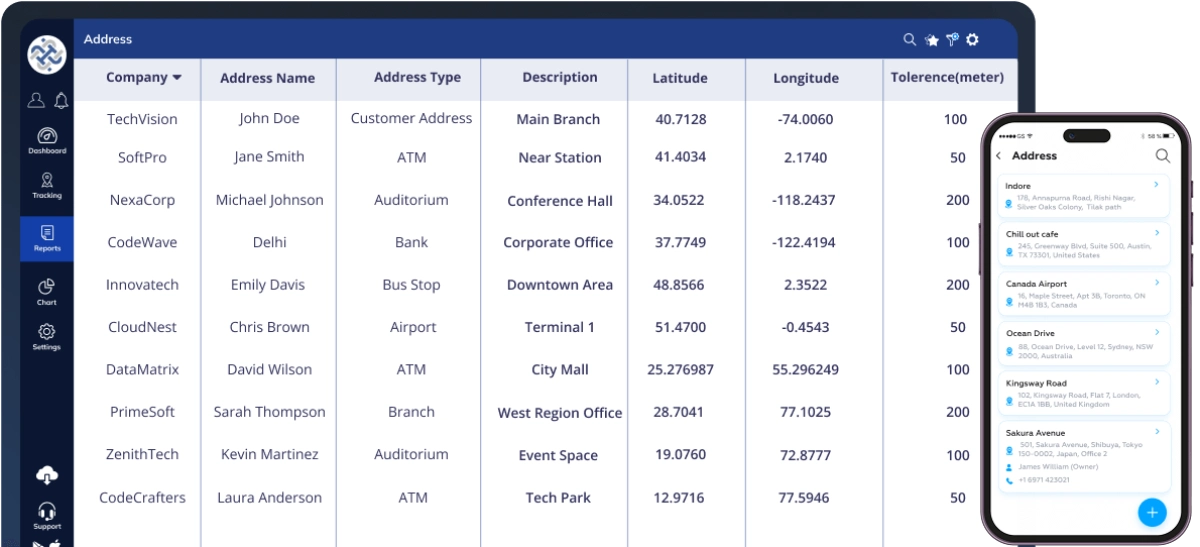
Address Management in Zard Teams App
Streamline Location Handling for Smarter Field Operations
The Address Management feature in the Zard Teams App helps organizations centralize, organize, and utilize location data with precision.
It enables managers to easily assign tasks, plan routes, and coordinate on-site operations while ensuring field teams always have access to accurate, real-time location information.
Whether it’s delivery points, service sites, warehouses, or customer locations — Zard Teams keeps your entire address network organized, up to date, and fully integrated with field workflows.
Highlights of Address Management
1. Organized and Actionable Location Data
Empower managers to build a structured and intelligent address database that simplifies operations, dispatching, and planning.
-
Create and Categorize Locations: Define offices, warehouses, customer sites, or delivery zones for better alignment with ongoing tasks.
-
Custom Labels and Tags: Assign names, labels, or color codes to easily identify address types and purposes.
-
Smart Search and Filters: Quickly find addresses based on region, type, client, or project criteria.
-
Seamless Task Integration: Link address data directly to assignments for faster, location-based task deployment.
-
Comprehensive Metadata: Access full address details and contextual information to support route optimization and performance analysis.
2. Real-Time Location Access for Field Teams
Ensure every on-site employee reaches the right place at the right time with minimal effort.
-
Instant Access: Field agents can view assigned addresses instantly within the app.
-
Contextual Labels: Understand whether a location is a client visit, delivery stop, or maintenance site.
-
Live Updates: Receive automatic address updates in real time for accurate navigation.
-
Integrated Navigation: Launch directions directly from linked tasks to the mapped destination.
Benefits of Address Management
1. Fewer First-Time Visit Failures
Accurate, labeled addresses minimize confusion and wrong visits — especially useful for new or substitute field staff handling unfamiliar routes.
2. Smarter Territory Planning
Analyze address density and frequency to optimize territory mapping, resource distribution, and identify expansion opportunities.
3. Batch Routing Efficiency
Plan and group visits by area or task type to complete multiple stops efficiently, reducing travel time and operational costs.
4. Reduced Communication Delays
Clear, pre-labeled addresses reduce repetitive calls and clarifications between field agents and managers, improving overall coordination.
5. Standardization Across Distributed Teams
A centralized address database ensures consistent naming conventions and data formats across regions, minimizing confusion and data errors.
6. Audit-Ready Compliance
Historical visit data and location logs provide reliable evidence for SLA compliance, legal verification, and audit reports.
7. Predictive Planning with Geospatial Insights
Analyze service locations and patterns to forecast demand, allocate resources proactively, and improve overall operational intelligence.
8. Faster Emergency Dispatching
Centralized address visibility enables dispatchers to identify the nearest available field agent and respond to urgent tasks instantly.
9. Improved Customer Experience
Accurate address data ensures on-time visits and successful service completion, fostering trust and stronger client relationships.
Industry Applications
Field Workforce & Task Management
Plan and organize job sites or maintenance zones for efficient workforce routing in construction, utilities, and mining.
Logistics, Delivery & E-commerce
Manage delivery points, route hubs, and distribution centers to optimize delivery efficiency and minimize delays.
Sales, Surveys & Customer Engagement
Assign and track sales or survey routes by geography and customer data for improved field productivity.
Support & Technical Services
Track installation sites, service appointments, and client locations with real-time address updates.
Emergency & Public Services
Maintain prioritized databases of hospitals, shelters, or rescue zones to enable faster, more accurate response times.